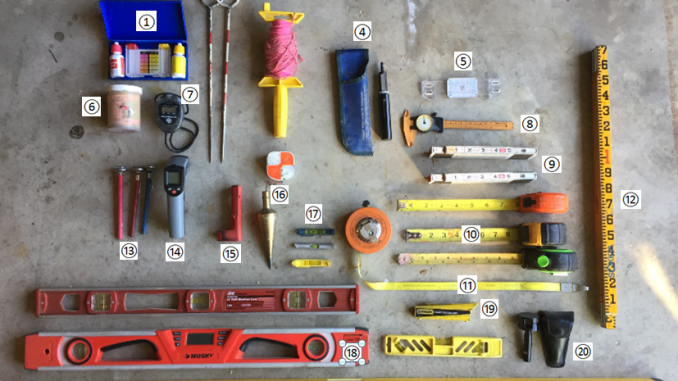
Recently, I was doing my end-of-construction-season toolbox inventory – I cleaned-out my kit, did some equipment checks, made a list of a few items that I need to pick-up/replenish/replace. I thought it would be cool to do an article on the gear that I have in my in my kit. I’ve seen lots of web posts about Everyday Carry’s (EDC’s) that guys have showing knives, phone cords, etc., but I’ve never seen a article from a Civil Engineer or Construction Engineer on what they carry day-to-day.
All of this gear is kept in a couple of toolboxes in my truck, as it has been for decades. Every construction engineer should have the right gear on-board and always be prepared to get the job done. There’s no excuse for not being prepared….
Layout & Marking Items
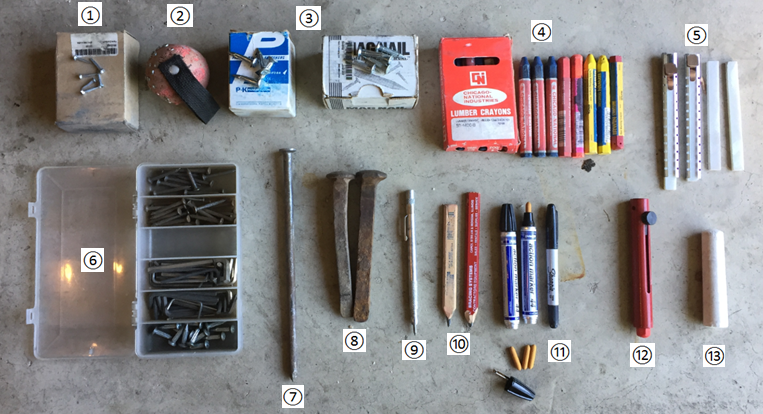
-
Tacks
Tacks are typically used on wood hub tops for precise layout
-
Tack Ball
A great invention – A tack ball is just a kid’s rubber ball with a strap on it. My tack ball hangs off my tool belt – You load it with tacks, makes it easy to pull them off and drive them
-
PK Nails / Mag Nails
The work-horse of all layout marks, anything in the pavement requires nails. Most guys like to use Mag Nails because they are heavier-duty, but I keep a box of PK Nails as well. All the nails come in various types of sizes & lengths
-
Lumber Crayons / Keel
I go through keel & crayons like crazy. They are easy to keep on you while you’re out, great for quickly scribing information on barriers & curbs. Keel will wash off because it’s more chalk-based, but lumber crayons typically wax-based and will adhere for a longer duration
-
Soapstone
I love soapstone – It is THE way to mark structural steel. It’s relatively brittle, so a sliding holder is a great addition
-
Concrete Nails
I always like to keep different odd-pall nails on-board, concrete nails become another option depending on what needs to be marked.
-
Long Spikes
-
Railroad Spikes
Great for setting benchmarks in utility poles. I should keep more of these on-board because they are always in short supply.
-
Scribe
A scribe is great for marking stone, concrete or steel surfaces. They have replaceable carbide tips (which I need to pick up some spares….).
- Lumber Pencils
-
Marks-a-Lots / Action Markers
Markers are another staple in any surveyors kit. Action markers, are a step-above a Sharpie. I know a lot of guys like Sharpies because they can be purchased anywhere, but I find that Sharpies dull really quickly. Marks-a-Lot pens have a depressible tip that allows you to re-ink. And the tips (in orange, below the markers) if you wear them out before the ink is used up. I always like to keep a couple of extra caps since they have a way of getting lost while you’re out…
-
Lumber Crayon Scribe
I keep this in my tool pouch, but candidly, I don’t like this one – The crayon/keel never seems to stay in them. Maybe mine is old…
-
Railroader’s Chalk
Chalk is nice for marking steel or rail (as its name suggests, of course…)
Measuring Tools
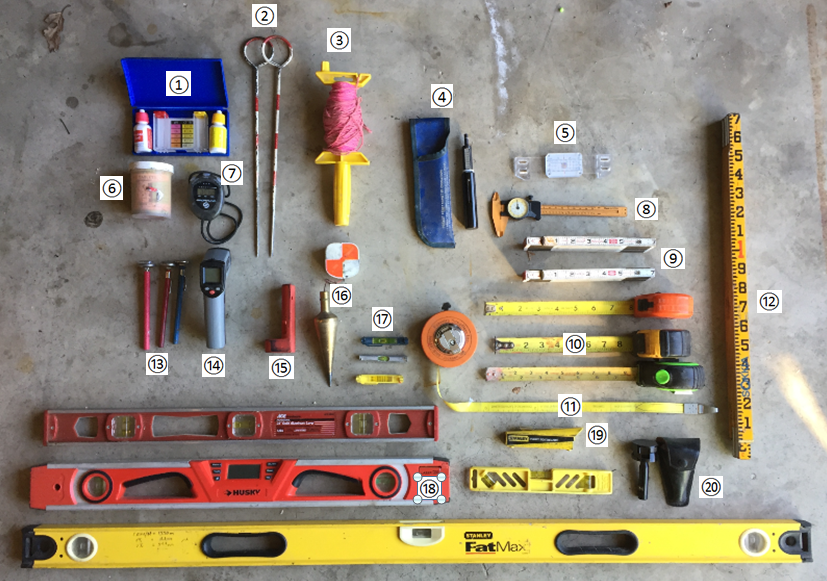
-
Pool Test Kit
This is one of those odd-ball tool-box items, but I kid you not, I used this kit about a half-dozen times this past summer to diagnose ground water infiltration to determine if it was from a water main break.
-
Chaining Pins
Every engineer needs a “Stupid-End-of-the-Tape” second-hand. Yes, a rock or a brick work in a pinch. I always keep spares as the guys who work with my will often “10-Finger Discount” mine….
-
String Line
A staple in the field engineer’s arsenal. Get yourself a spool: Sure, a piece of wood works, but you’re a professional – Have right tools.
-
Pocket Penetrometer
I think that every construction engineer should have one of these in their tool-boxes for checking in-situ soil strength. Most companies will keep one in the field office, but I’ve always carried my own: There’s nothing worse than telling a Contractor “Oh, wait, let me run back to the field office….”
-
Crack Gauge
I keep 3 of these in my truck – They are reusable. They are made from 2 pieces of plexiglass and can be mounted on any surface to monitor crack movements in either 1 or 2 directions. We used these at the Museum of Science and Industry to monitor cracks in the façade while we were driving piling nearby. Not often used, but good to have just-in-case.
-
Dye Tabs
Like the pool test kit, this is an odd-ball item that, again, got used a few times this last summer. Non-toxic fluorescent die tabs can be dropped in sewer structures to trace where the water is flowing
-
Stopwatch
Hopefully you read my article on Alternate Methods of Pile Driving where this came in handy. Of course, everyone has stopwatches on their phones, but I’d much rather drop this $8 stopwatch than my phone if I’m out on the site….
-
Calipers
A must for thickness measurements.
-
6′ Folding Ruler
I always keep a couple of back-ups since they have a tendency to break. These are the way to go for string-line depth measurements. Keep some WD-40 or some grease in your kit to keep them lubed-up.
-
Retractable Tapes
You can never have enough tapes. I always keep several different measuring grades – 10ths is what is typically used by surveyors and heavy highway guys since that’s the units we work in, but building guys & carpenters will work in 16ths of an inch, so you need to be prepared.
-
Tree Tape
Most companies will keep a tree tape in their offices for the whole crew to use, but I always have had my own. If you’ve never used one, the tape is used to wrap around the circumference of a tree with the markings being a direct read/conversion to the diameter.
-
Folding Surveyor’s Rod
I picked this up about 20 years ago and love it – It is a folding surveyors rod. It’s stiff enough to use for taking quick measurement but compact and fits in my toolbox
-
Thermometers
I have both low-temp and high-temp thermometers, but I can’t think of the last time I used the high-temp for asphalt. Obviously, these are a must for checking concrete temps
-
Laser Thermometer
When these first came out, they were over $100, and most companies would buy one to give to their materials inspectors for checking asphalt temps. Now, you can pick these up for less than $20. Obviously these are great for checking asphalt temperatures, but I think I’ve used mine more for checking pavement surface temperatures for striping.
-
Rod Level
I wish I could have gotten a better picture of this, but these are used on the side of a grade rod to check for plumbness/level. Great to have when you are running level loops, makes “Rocking the Rod” a little cleaner exercise.
-
Plumb Bob & Gammon Reel
I’ve probably worn-out a half-dozen Gammon reels (the retractable string on the plumb) and should keep an extra in my kit. I don’t need to explain how important having a plumb bob is seeing as they’be been used since the pyramids were built….
-
Line Level
These are awesome – They attach to your string line for checking grades between points.
-
Levels
You can never have too many levels. 2-footers, 4 footers, torpedos, laser/Smart levels.
-
Hand Level (Peep Sight)
These are nice to have for rough checks. I like to use mine for checking my rotating laser setups to make sure that my laser will be able to read the points I plan to shoot
-
90 degree Prism
I can’t say I’ve used this guy in a while, but you never know. This is used to sight forward on a point but, with mirrors inside of it, allows you to see/sight/mark 90-degrees from the point you’re sighting
Engineer’s Tools/Gear

-
300′ Tape
I’ve kept a 300′ tape in my arsenal for years, more and more guys are also adding them to their kits. Think of how many times you need more than 100′ of tape…
-
100′ Tape
The construction engineer’s workhorse. I always keep a spare in my truck. Also, you might notice the heavy duty bolts I have on the end of mine – This is great for vertical measurements (like foundations, or top-to-bottom structure measurements).
-
Hammers
I’ve always been a fan of the short, stubby, heavy engineer’s hammer. If I’m going to hit something, I want to leave a mark.
-
Cold Chisel
Great for marking cross-hairs in concrete.
-
First Aid Kit
Most of us already have these in our trucks. Here’s a question for you – When is the last time you’ve inventoried yours? Have any of the medications expired? Make a point of checking yours this week and get expired stuff swapped-out.
-
Tool Rig
Undoubtedly my Best Friend and my favorite piece of my kit – We’ve been through a lot of shyt together. The pouch on the left is my original from 1989, I added the 2nd pouch in the mid ’90s and have gone through several belts since then. Being able to be Hands Free while you’re out measuring/working is a must.
- Paint
-
Hand Broom
I’ve always kept a small hand broom in my kit, you’d be amazed at how many times this gets pulled out during the season.
-
Gloves
I’ve like a glove junkie, I swear…..they are like Carhartt T-shirts, you can never have enough of them.
-
Small Shovel
I want to try to find & purchase a folding survival shovel this year. I’ve had this one for years, extremely handy. It’s small, but it’s tough to store in my truck/boxes.
-
Washers (???)
What??!! Why washers? Well, I use these a lot for weighting strings. But they are perfect for locking manhole lids in place. Look for a post in the near future about this….
-
Harness
Not a lot of construction engineers have their own, most companies keep a couple in-stock for their guys to use. I like to have a belt on-board all the time – I never want to NOT be able to check something because of an access or safety concern.
And also a Sewer Hook is a must-have (I forgot to put mine in the picture, it was in my truck when I took the photos).
After Actions
I hope you enjoyed the tour. Take some time this week to run through your toolboxes:
–Are there any tools you need to add to your kit?
–Are you out of anything?
–Is any of your gear trashed and needs to be replaced?
You can NEVER have enough tools. Be prepared for anything you might need to do on-site. Make a list and either buy the gear you need yourself or send your list up the Chain of Command at work.
And the Last Word – An engineer should never make a Contractor wait because he/she was unprepared. Have the tools you need with you. Always be prepared to work.

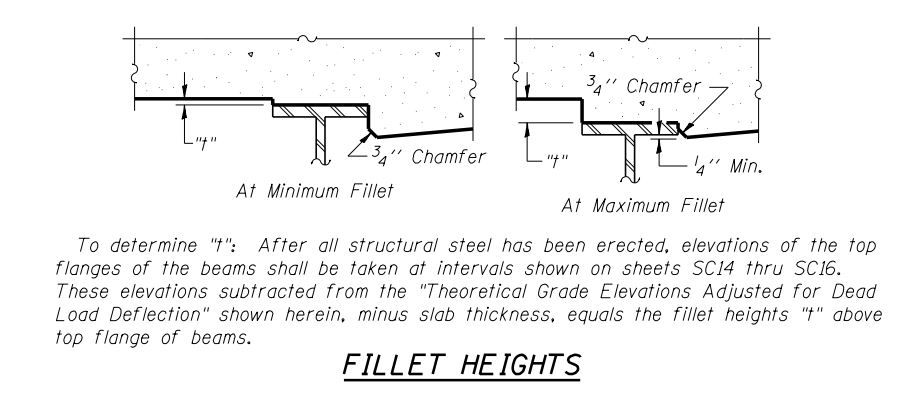
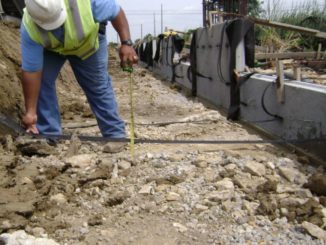

Informative
wow! i totally get you… edc everywhere and not what we actually need or aught to have on hand… great piece…